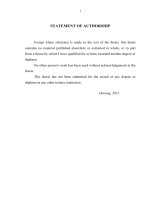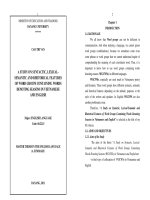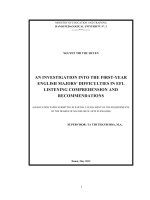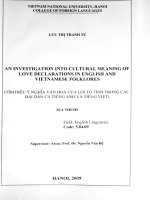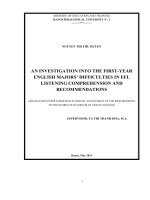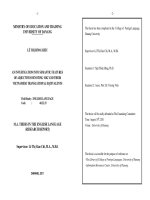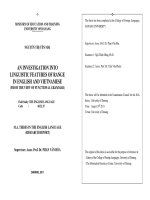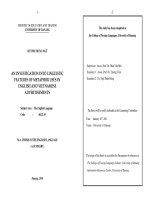An investigation into cultural features of english slangs containing words denoting animals
Bạn đang xem bản rút gọn của tài liệu. Xem và tải ngay bản đầy đủ của tài liệu tại đây (272.1 KB, 13 trang )
TẠP CHÍ KHOA HỌC ĐHSP TPHCM
Số 8(86) năm 2016
_____________________________________________________________________________________________________________
AN INVESTIGATION INTO CULTURAL FEATURES
OF ENGLISH SLANGS CONTAINING WORDS DENOTING ANIMALS
ĐINH QUANG TRUNG*
ABSTRACT
Understanding and using slangs correctly is not an easy task for English learners if
we just base on their literal meanings. Language and culture are undoubtedly closely
integrated and interdependent during their whole development processes. Therefore, in
this article, an investigation into cultural feature of 359 English slangs containing words
denoting animals was conducted to bring readers an insight.
Keywords: slang, cultural features, animal.
TÓM TẮT
Khảo sát về tiếng lóng Anh ngữ chứa từ chỉ động vật dưới khía cạnh văn hóa
Hiểu và sử dụng đúng tiếng lóng không hề dễ dàng đối với người học tiếng Anh vì
hiểu nó không đơn thuần chỉ dựa vào nghĩa đen của từ ngữ. Ngôn ngữ và văn hóa có mối
quan hệ khắn khít và tác động lẫn nhau. Vì thế 359 tiếng lóng Anh ngữ chứa từ chỉ động
vật được khảo sát trong bài báo này nhằm đem lại cho người đọc về khía cạnh văn hóa mà
chúng phản ánh.
Từ khóa: tiếng lóng, văn hóa, động vật.
1.
Statement of the Problem
In learning and communicating process, non-native speakers of English can reach
a point in their knowledge of the language where they feel comfortable with standard
literary speech. They are, however, liable to get confused when they confront slangs- a
linguistic modality confined to spoken language, has always been difficult to locate, to
explain and to grasp as a unitary phenomenon.
Slang is full of vivid reality that almost any language has, whether wanted or not.
The writer Victor Hugo took notice of using slangs in his work “Le dernier Jour d'un
Condamne” (1828). He even devoted his entire volume VII in the fourth section of the
massive popular novel “Les Miserable” (1861) to discuss the slang. Slang is language
deliberately selected for its striking informality and is consciously used in preference to
proper speech (or, more rarely, writing). It usually originates in small social group. For
these groups, it is a private code that embodies their particular values and behavior and
reinforces their exclusivity. As a result, understanding and using slangs correctly and
effectively is not an easy task. Sometimes, non-native speakers of English find it
difficult to comprehend what is meant by English slangs as well as what structures the
slangs belong to. Moreover, slangs denoting animals are various in the ways of
*
M. A., Ton Đuc Thang high school, Khanh Hoa province; Email:
54
TẠP CHÍ KHOA HỌC ĐHSP TPHCM
Dinh Quang Trung
_____________________________________________________________________________________________________________
expressing their meanings because, in some cases, we cannot understand some
expressions by basing on their literal meanings. As a matter of fact that you frequently
hear such slangs from animals in your daily life:
- My God, he made a real dog’s breakfast of that presentation”. [9, p.132]
- We ain’t gonna walk no eight miles… tonight. My dogs are burned up.
p.11]
[1,
- Man, who was that fox I saw you with? [8, p.78]
- Plinio, the barman with duck’s disease came running up. [1, p.11].
Very often we understand every individual word in this sentence but still fail to
grasp what the sentence is all about. Thus, if we do not learn slangs in general and
slangs containing words denoting animals in particular, we cannot understand their
exact meanings. It means that it’s so difficult for us to master the deeply true and full
meaning of such the phrase as dogs, dog’s breakfast, fox, duck’s disease if you are
not under the light of slang, especially slangs containing words denoting animals. In
consequence, we lose interaction in communication because we cannot understand
speakers’ intentions and opinions. Moreover, learning these kinds of slangs makes nonnative learners of English understand and uses English more confidently, effectively
and naturally.
Hopefully, this research will enable us to understand the cultural features of
English slangs containing words denoting animals and use them in sensible as well as
productive ways. Besides, learning such these slangs is one of the best ways to add to
and develop our vocabulary. And with the respect to culture, language learners can get
acquainted with the past and present social life of the people with theirs way of living,
way of thinking and theirs traditions via slangs.
For the above reasons, the topic “An Investigation into Cultural Features of
English Slangs Containing Words Denoting Animals” has been chosen for my
article.
2.
Problem solution
2.1. Definition of slang
According to Yule [10, p. 211], he defines slang in his work- The Study of
Language as following “slang describes words or phrases that are used instead of more
everyday terms among younger speakers and other groups with special interests”.
In The Concise New Partridge Dictionary of Slang and Unconventional English
by E. Partridge and P. Beale [6], slang is “a peculiar kind of vagabond language,
always hanging on the outskirts of legitimate speech, but continually straying or
forcing its way into the most respectable company”. As noted by Dalzell and Victor
(2008: xv), “slang is easy enough to use, but very hard to write about with the facile
55
TẠP CHÍ KHOA HỌC ĐHSP TPHCM
Số 8(86) năm 2016
_____________________________________________________________________________________________________________
convincingness that a subject apparently so simple would, at first sight, seem to
demand”.
“Slang is a language which rolls up its sleeves, spits on its hands- and goes to
work” Carl Sandburg- an American poet once described [13]. As to Chesterton G.K, he
referred to slang as “the one stream of poetry which is constantly flowing”. [2, p. 61].
Another definition of slang is that slang is “words or expressions that are very informal
and are not considered appropriate for more formal situations. Some slang is used only
by a particular group of people” in Macmillan English Dictionary For Advanced
Learners of American English. [5, p.354]
2.2. Literature review
Up to now, slangs have been a growing interest of researchers. In fact, slang has
become a subject of study by several British, American… and even Vietnamese writers
and linguists. In “An Introduction to English Slang” (2008) by Elisa Mattiello, slang
was fully described in terms of features of its morphology, semantics and sociology. A
study of how to speak and understand American slang and how slang used in popular
American television shows was carried out by David Burke in two works “Street talk
1” (2001) and “Street Talk 2” (2001). Eric Partridge examined slangs under different
approach. He discussed the sketch of the history of English slang and investigated
slangs in some particular aspects such as journalism, art, medicine, etc. in “Slang ToDay and Yesterday” (2007). “The Oxford Dictionary of Slang” (1998) by John Ayto is
a good dictionary of slang. It is a collection of slangs which are arranged in a particular
area of activity or concept. In addition, there are some other dictionaries of slang like:
“Dictionary of Contemporary Slang” (2007) by Tony Thorne, “The Concise New
Partridge Dictionary of Slang and Unconventional English” (2008) E. Partridge and P.
Beale, “Mc Graw-Hill’s Super-mini American Slang Dictionary” (2007), “Mc GrawHill’s Essential American Slang Dictionary” (2000) and “NTC’s Dictionary of
American Slang and Colloquial Expressions” (2007) by Richard Spears, etc.
Besides above-mentioned works, it’s to blame if we forget to talk about the
following other remarkable ones. As we know that slang is a language that touches
such every field and profession in society as “Cop Talk” by Lewis Poteet and Aaron C.
Poteet (2000)- a dictionary of police slang, “Military Slang” by Lee Pemberton (2006)a collection of slang in army, “Public school Slang” by Morris Marples (1940)- a work
of slang used at school, “Cowboy Slang” by Frosty Potter and Edgar F. Potter (1986)the colorful, humorous lingo of the American West captured here in 2000 phrases and
expressions.
In Vietnamese, up to now, some authors have paid attention to slang. In “Từ Điển
Tiếng Lóng và những Thành Ngữ Thông Tục Mỹ-Viêt” (2006) by Bùi Phụng, it is a
useful collection of American-Vietnamese slangs and colloquial expressions. Besides,
there are some valuable materials about slang as “Sổ Tay Từ-Ngữ Lóng Tiếng Việt”
(2008) by Đoàn Tử Huyến & Lê Thị Yến , “Tiếng Lóng Việt Nam” (2001) by Nguyễn
56
TẠP CHÍ KHOA HỌC ĐHSP TPHCM
Dinh Quang Trung
_____________________________________________________________________________________________________________
Văn Khang and “Tiếng Lóng trong Giao Thông Vận Tải” by Chu Thị Thanh Tâm
(1998).
As to Phạm Hoài Anh, “The Use of and the Attitudes toward Slang Expressing
Surprise and Disbelief among Young Americans” really draws her attention in doing a
research as M.A linguistics thesis (2010) at the College of Foreign Languages, the
University of Ha Noi. At the College of Foreign Languages, the University of Da
Nang, Tạ Thị Mười’s MA thesis with the title is “An Investigation into Linguistic
Features of English Originated Slangs Used by Vietnamese Young People in PresentDay Life”.
Although some various aspects of slangs have been investigated, up to now, no
concern has been paid to slangs containing words denoting animals and their cultural
features deeply and systematically. This is reason why “An Investigation into
Cultural Features of English Slangs Containing Words Denoting Animals” comes
into being investigated in an attempt to find out the cultural features of English slangs
containing words denoting animals.
2.3. Sampling
The samples should include 359 English slangs that contain words denoting
animals. Data for research were collected from main books and dictionaries such as
Oxford Dictionary of Slang by John Ayto (1998), Dictionary of Contemporary Slang
by Tony Thorne (2005), The Concise New Partridge Dictionary of Slang and
Unconventional English by Eric Partridge and P. Beale (2008), Vice Slang (2008) and
Sex Slang (2008) by Tom Dalzell and Terry Victor, Mc Graw-Hill’s super-mini
American slang dictionary (2007), Mc Graw-Hill’s essential American slang
dictionary (2007) by Richard Spears.
Besides, they were searched from the websites on the internet like
, />2.4. Data analysis
This study was carried out throughout descriptive, analytical and qualitative
methods. Data analysis consists of the following steps:
Step 1: To assemble English slangs containing words denoting animals from
books, dictionaries and on the internet. They were collected randomly in a large
quantity of 359 slangs.
Step 2: To make a general survey of English slangs containing words denoting
animals after the stage of collection. In this stage, the samples from the collected data
should be sorted into different categories in terms of species.
Step 3: To discover the cultural feature of English slangs containing words
denoting animals, the denotations of each species that imply deserved to mention. A
survey was certainly carried out to find out the cultural features slangs from animals
imply.
57
Số 8(86) năm 2016
TẠP CHÍ KHOA HỌC ĐHSP TPHCM
_____________________________________________________________________________________________________________
Step 4: To get the results and conclusion.
3.
Results
Slangs containing words denoting animals that are surveyed have a big number of
different species; therefore, they are divided into three groups for purpose of
convenience of investigation: group 1:animals are usually raised or seen in the people’s
surroundings (called familiar animals) (198/359), group 2 :animals that live or are
usually seen in the natural surroundings (called wild animals) (155/359) and group 3:
insects (6/359)
3.1. The cultural characteristics of words denoting such familiar animals as dogs,
cats, pigs, chicken, etc.
3.1.1. The cultural characteristics of “Dog” through slangs (46)
- “Dog” implies a person. For example:
+ a dog (an ugly, unpleasant or unattractive woman or girl) [9, p.130]
- “Dog” implies sex. For example:
+ dog fashion (sexual intercourse from behind)
[3, p.49]
+ dog style (a sexual position)
[3, p.49]
- “Dog” implies a bodily function. For example:
+ dog-log (a section of dog feces)
[8, p.61]
- “Dog” implies alcohol. For example:
+ brewdog (a can of beer)
[6, p.207-208]
+ dog juice (inexpensive alcohol)
[4, p.58]
- “Dog” implies education. For example:
+ dogger (a truant)
[9, p.131]
+ dog it (to play truant)
[9, p.131]
- “Dog” implies unpleasantness. For example:
+ dirty dog (a despicable or untrustworthy person)
[6, p.207-208]
+ dog’s mother (a bitch, a bitchy person)
[8, p.61]
There are many other slangs having the word “dog” but they are not all analyzed
in this study because of the great number. However, the common implications of the
word “dog” have been analyzed. According to the survey in this study, there are over
80% slangs from the word “dog” in which dog implies a bad thing , sex or a bad person
like “dog”, “dog it”, “dog fashion” etc... The frequency of dog in slangs, anyway,
shows that dog is a very familiar animal in life.
3.1.2. The cultural characteristics of “Cat” through slangs (21)
- “Cat” implies excellence, remarkableness. For example:
58
Dinh Quang Trung
TẠP CHÍ KHOA HỌC ĐHSP TPHCM
_____________________________________________________________________________________________________________
+ cat’s ass (an extraordinarily good or extraordinarily bad example of something)
[6, p.123]
- “Cat” implies pleasure and enjoyment. For example:
+ play cat and mouse (of two groups or people, to pursue)
[12]
- “Cat” implies crime. For example:
+ cat walker (a burglar who steals at night)
[6, p.124]
- “Cat” implies cards, gambling. For example:
+ cat’s eyes (in craps, a roll of three)
[4, p.36]
- “Cat” implies sexual orientation. For example:
+ cat lapper (a lesbian)
[3, p.28]
- “Cat” implies a bodily function. For example:
+ shoot the cat/whip the cat (to vomit)
[1, p.20]
- “Cat” implies trouble. For example:
+ set the cat among the pigeons (to make trouble)
[1, p.243]
- “Cat” implies unpleasantness. For example:
+ cat (a spiteful woman)
[9, p.83]
Above are just some cultural characteristics of “cat”. The word “cat” has different
denotations in English. They may be positive or good things like “cat”. However the
bad ones or something that people do not want to mention directly is more like “cat
lapper”, “cat walker”, “shoot the cat”... This means that “cat” plays different roles in
life.
3.1.3. The cultural characteristics of “Pig” through slangs (21)
- “Pig” implies physique. For example:
+ hellpig (an fat or overweight person)
[8, p.107]
- “Pig” implies eating and drinking. For example:
+ pig out (to eat excessively or messily)
[9, p.334]
- “Pig” implies work. For example:
+ pig sticker (a butcher)
[1, p.196]
- “Pig” implies sex. For example:
+ pig party (serial consensual sex between one person and multiple partners)
[3, p.133]
- “Pig” implies the police. For example:
+ pig heaven (a police station)
- “Pig” implies ugliness. For example:
59
[8, p.159]
Số 8(86) năm 2016
TẠP CHÍ KHOA HỌC ĐHSP TPHCM
_____________________________________________________________________________________________________________
+ pig in knickers (very unattractive female)
[6, p.495]
- “Pig” implies a place. For example:
+ pig’s ballroom (a bar or club where unattractive females congregate) [6, p.495]
Here are some of many cultural characteristics of “pig”. As we knew, pigs are a
kind of animal that overeats and big. Not surprisingly, the slang of “pig” implies
weight and eating. Besides, “pig” is used to denote sex or ugliness. These
characteristics are the same in Vietnamese slang “ăn như heo, phim con heo”.
3.1.4. The cultural characteristics of “Horse” through slangs (13)
- “Horse” implies drugs and tobaccos. For example:
+ horse (heroin)
[9, p.225]
+ horseshoe (a hand-rolled cigarette, especially one containing strong tobacco)
[9, p.225]
- “Horse” implies foolishness. For example:
+ horse’s ass (a fool, especially an annoying one)
[9, p.225]
- “Horse” implies a foodstuff. For example:
+ horse cock (a large sausage)
[7, p.111]
- “Horse” implies pleasure, enjoyment. For example:
+ horse about/around (to have fun, to have a good time) [1, p.236]
Although most of the characteristics of “horse” are about drug, tobacco as well as
foolishness like “horse”, “horse’s ass”, horseshoe”, few of them denote fun or pleasure
“horse about”.
3.1.5. The cultural characteristics of “Duck” through slangs (9)
- “Duck” implies the body and its parts. For example:
+ duck’s disease (shortness of legs)
[1, p.11]
- “Duck” implies people. For example:
+ mud duck (a ugly person)
[8, p.140]
- “Duck” implies cards, gambling. For example:
+ duck bucket (a poor hand that wins a pot, especially a pair of twos, in poker)
[4, p.63]
- “Duck” implies easiness. For example:
+ duck soup (something easy to do, easiness)
[1, p.406]
- “Duck” implies air-force. For example:
+ duck (an aircraft)
[9, p.144]
60
Dinh Quang Trung
TẠP CHÍ KHOA HỌC ĐHSP TPHCM
_____________________________________________________________________________________________________________
3.1.6. The cultural characteristics of “Chicken” through slangs (10)
- “Chicken” implies cowardice. For example:
+ chicken (a coward)
[9, p.87]
+ chicken out (to lose courage and retreat from an endeavor) [6, p.133]
- “Chicken” implies foolishness. For example:
+ chicken-head (a foolish female)
[9, p.88]
- “Chicken” implies money. For example:
+ chicken feed (a small amount of money)
[1, p.183]
+ chicken’s neck (a cheque)
[6, p.134]
- “Chicken” implies prostitution. For example:
+ chicken ranch (a rural brothel)
[3, p.31]
- “Chicken” implies contemptibleness. For example:
+ chickenshit (anything worthless, petty or contemptible)
[9, p.88]
From the above-described characteristics, it’s not absolutely difficult to realize
that most of the “chickens” imply such the bad things as cowardice, foolishness,
prostitution or contemptibleness.
3.1.7. The cultural characteristics of “Sheep” through slangs (6)
- “Sheep” implies sex. For example:
+ sheep (a woman who volunteers to take part in serial sex with members of a
motorcycle club or gang)
[3, p.159]
+ sheep’s eyes (a glance indicative of infatuation)
[1, p.65]
- “Sheep” implies business, commerce. For example:
+ sheep’s back (the wool industry)
[6, p.571]
- “Sheep” implies alcohol. For example:
+ sheep-dip (low quality alcoholic drink)
[9, p.386]
3.1.8. The cultural characteristics of “Mouse, Rat” through slangs (23)
- “Mouse” implies sex. For example:
+ double-click one’s mouse (to masturbate)
[3, p.51]
- “Mouse” implies a foodstuff. For example:
+ mousetrap (cheese)
[1, p.136]
- “Mouse” implies people using computer. For example:
+ mouse potato (someone who spends a great amount of time using a computer)
[8, p.140]
61
TẠP CHÍ KHOA HỌC ĐHSP TPHCM
Số 8(86) năm 2016
_____________________________________________________________________________________________________________
- “Rat” implies drunkenness. For example:
+ rat-arsed/rat-faced (drunk)
[9, p.358]
- “Rat” implies bad quality. For example:
+ ratshit (worthless, inferior, utterly disappointing)
[9, p.359]
- “Rat” implies cards, gambling. For example:
+ rats and mice (a game of dice)
[1, p.360]
- “Rat” implies illness. For example:
+ rat bite (a skin bruise caused by sucking)
[3, p.147]
- “Rat” implies insanity. For example:
+ rat house ( a mental hospital)
[1, p.305]
The image of “rat, mouse” is often in association of dirtiness or illness. Under the
light of slang, rat or mouse is completely alike. Their implications are the bad things
that occasionally occur in our daily lives like drunkenness, sex, gambling, or disease.
3.2. The cultural characteristics of words denoting such wild animals as whale,
monkey, lion, tiger, etc.
3.2.1. The cultural characteristics of “Monkey” through slangs (20)
- “Monkey” implies money. For example:
+ monkey (£500)
[9, p.295]
- “Monkey” implies sex. For example:
+ monkey spank (of a male, an act of masturbation)
[3, p.118]
- “Monkey” implies the body and its parts. For example:
+ monkey box (the vagina)
[3, p.118]
+ monkey’s tail (a nail)
[6, p.437]
- “Monkey” implies temperature. For example:
+ monkey bath (a very hot bath)
[6, p.437]
- “Monkey” implies tobacco. For example:
+ monkey’s nuts (cigarette butts)
[6, p.437]
- “Monkey” implies alcohol. For example:
+ monkey swill (inferior, strong liquid)
[8, p.139]
- “Monkey” implies a foolish behavior. For example:
+ monkey-shines (foolish behavior)
[1, p.312]
Five out of eight characteristics of “monkey” are used of refer the bad things
under the language of slang like sex, foolishness and alcohol.
62
TẠP CHÍ KHOA HỌC ĐHSP TPHCM
Dinh Quang Trung
_____________________________________________________________________________________________________________
3.2.2. The cultural characteristics of “Fox” through slangs (5)
- “Fox” implies slyness. For example:
+ fox (a sly person)
[1, p.291]
- “Fox” implies alcohol. For example:
+ fox and hound (a round of drinks)
[6, p.266]
- “Fox” implies an ethnic, national group. For example:
+ fox hunter (an English man)
[6, p.267]
Not surprisingly, most of the characteristics of “fox” are to denote the bad things
because of the natural symbols of fox in many different cultures in the world.
3.2.3. The cultural characteristics of “Mule” through slangs (6)
- “Mule” implies sex. For example:
+ lope your mule (to masturbate)
[3, p.108]
- “Mule” implies cards, gambling. For example:
+ mule teeth (in craps, a roll of twelve)
[4, p.125]
- “Mule” implies a crime. For example:
+ mule (a smuggler)
[1, p.98]
3.2.4. The cultural characteristics of “Donkey” through slangs (7)
- “Donkey” implies time. For example:
+ donkey’s year (a very long time)
[1, p.361]
- “Donkey” implies sex. For example:
+ pull your donkey (to masturbate)
[3, p.50]
- “Donkey” implies difficulty. For example:
+ donkey work (difficult, menial work)
[6, p.211]
The image of donkey always reminds us of slow, difficult or hard working. The
“donkey” in slang is the same. They are mentioned about time, difficulty and menial
work.
3.2.5. The cultural characteristics of “Frog” through slangs (9)
- “Frog” implies an ethnic, national group. For example:
+ frog (a person who is French)
[9, p.170]
- “Frog” implies a place. For example:
+ frog and toad (a road)
[9, p.170]
- “Frog” implies a foodstuff. For example:
+ frog-spawn (a pudding)
63
[1, p.137]
TẠP CHÍ KHOA HỌC ĐHSP TPHCM
Số 8(86) năm 2016
_____________________________________________________________________________________________________________
- “Frog” implies money. For example:
+ frogskin (a bank note, a dollar bill)
[1, p.137]
- “Frog” implies a performance. For example:
+ frog salad (any performance that features scantily clad women, in carnival
usage)
[3, p.64]
+ frog show (a dance performance that features scantily clad women) [3, p.64]
- “Frog” implies education. For example:
+ frog slicing (a biology class/course)
[8, p.79]
3.2.6. The cultural characteristics of “Bird” through slangs (16)
- “Bird” implies the body and its parts. For example:
+ bird (the penis)
[3, p.13]
- “Bird” implies foolishness. For example:
+ birdbath (a silly person)
[9, p.40]
- “Bird” implies dismissal. For example:
+ get/give the bird (to dismiss, to be dismisses)
[1, p.204]
- “Bird” implies drugs. For example:
+ bird’s eye (a small dose of heroin)
[4, p.15]
- “Bird” implies sex. For example:
+ bog bird (a woman is willing to have sex in a public lavatory) [3, p.17]
The “bird” in slang is completely used to denote the bad things or something
people are shy to speak out like the part of the body, sex, drugs or foolishness.
3.2.7. The cultural characteristics of “Elephant” through slangs (5)
- “Elephant” implies an unattractive woman. For example:
+ elephant (an unattractive woman)
[9, p.152]
- “Elephant” implies drunkenness. For example:
+ elephant’s trunk (drunk)
[9, p.152]
- “Elephant” implies drugs. For example:
+ elephant juice (the drug etorphine)
[4, p.67]
- “Elephant” implies money. For example:
+ elephant bucks (a large amount of money)
[6, p.234]
3.2.8. The cultural characteristics of “Snake” through slangs (13)
- “Snake” implies sex. For example:
+ snake (to seduce or to have sex with)
[9, p.405]
64
TẠP CHÍ KHOA HỌC ĐHSP TPHCM
Dinh Quang Trung
_____________________________________________________________________________________________________________
- “Snake” implies work. For example:
+ snake charmer (a railway maintenance worker)
[1, p.199]
- “Snake” implies anger. For example:
+ snake-headed (angry)
[1, p.253]
- “Snake” implies cards, gambling. For example:
+ snake eyes (a throw of two ones with a pair of dice)
[1, p.359]
- “Snake” implies alcohol. For example:
+ snake juice (inferior whisky)
[1, p.144]
+ snake poison (whisky)
[1, p.146]
- “Snake” implies a place. For example:
+ snake room (a bar)
[4, p.170]
Almost all of the characteristics of “snake” are the bad things. They are sex,
gambling and alcohol. Basing on the survey, there is a positive feature mentioned in the
light of slang which is “snake charmer”
3.3. The cultural characteristics of words denoting such insects as bees and ants.
3.3.1. The cultural characteristics of “Bee” through slangs (5)
- “Bee” implies drugs. For example:
+ bee (a drug addition)
[4, p.12]
- “Bee” implies eagerness, enthusiasm. For example:
+ bee in one’s bonnet (obsession with something)
[1, p.245]
3.3.2. The cultural characteristics of “Ant” through slangs (1)
- “Ant” implies a bodily function. For example:
+ bark at the ants (to vomit outdoors)
4.
[11]
Conclusion
In short, many cultural characteristics of slangs containing words denoting
animals have been analyzed. It is clearly seen that the more popular the animal is, the
more cultural characteristics the animal has. In fact, such familiar animals as dogs, cats
and horses… have a lot of characteristics and such animals as crocodile, dragon and
lion… which rarely appear in daily life, have a few cultural characteristics. In this
study, a list of cultural characteristics of 39 kinds of animals from English has been
explored. It is not difficult to realize that most of the animals symbolize for more than
one specific characteristic, just a few reflect only one cultural feature. The study shows
the relationship between animals and people’s life by means of the figurative meanings
through animals’ images. As a feature of slang, most of slangs from animals are used to
symbolize the bad, the social aspects of life people shy to talk about.
65
TẠP CHÍ KHOA HỌC ĐHSP TPHCM
Số 8(86) năm 2016
_____________________________________________________________________________________________________________
REFERENCES
1.
2.
3.
4.
5.
6.
7.
8.
9.
10.
11.
12.
13.
Ayto J. (1998), Oxford Dictionary of Slang, Oxford University Press, New York.
Chesterton G.K (2008), The Defendant, Nu Vision Publication, LLC.
Dalzell T. and Victor T. (2008), Sex Slang, Routledge, London and New York.
Dalzell T. and Victor T. (2008), Vice Slang, Routledge, London and New York.
Macmillan (2002), English Dictionary for Advanced Learners of American English,
Macmillan Publishers Limited.
Partridge E. and Beale B. (2008), The Concise New Partridge Dictionary of Slang
and Unconventional English, Routledge, London and New York.
Spears R.A (2007), Mc Graw-Hill’s essential American slang dictionary, 2 nd edition,
Mac Graw Hill.
Spears R.A. (2007), Mc Graw-Hill’s super-mini American slang dictionary, 2nd
edition, Mac Graw Hill.
Thorne T. (2005), Dictionary of Contemporary Slang, 3nd edition, A& C Black
Publishers Ltd, London.
Yule G. (2006), The Study of Language, 3rd edition, Cambridge University Press.
/> /> />
(Received: 27/11/2015; Revised: 07/12/2015; Accepted: 27/8/2016)
66
